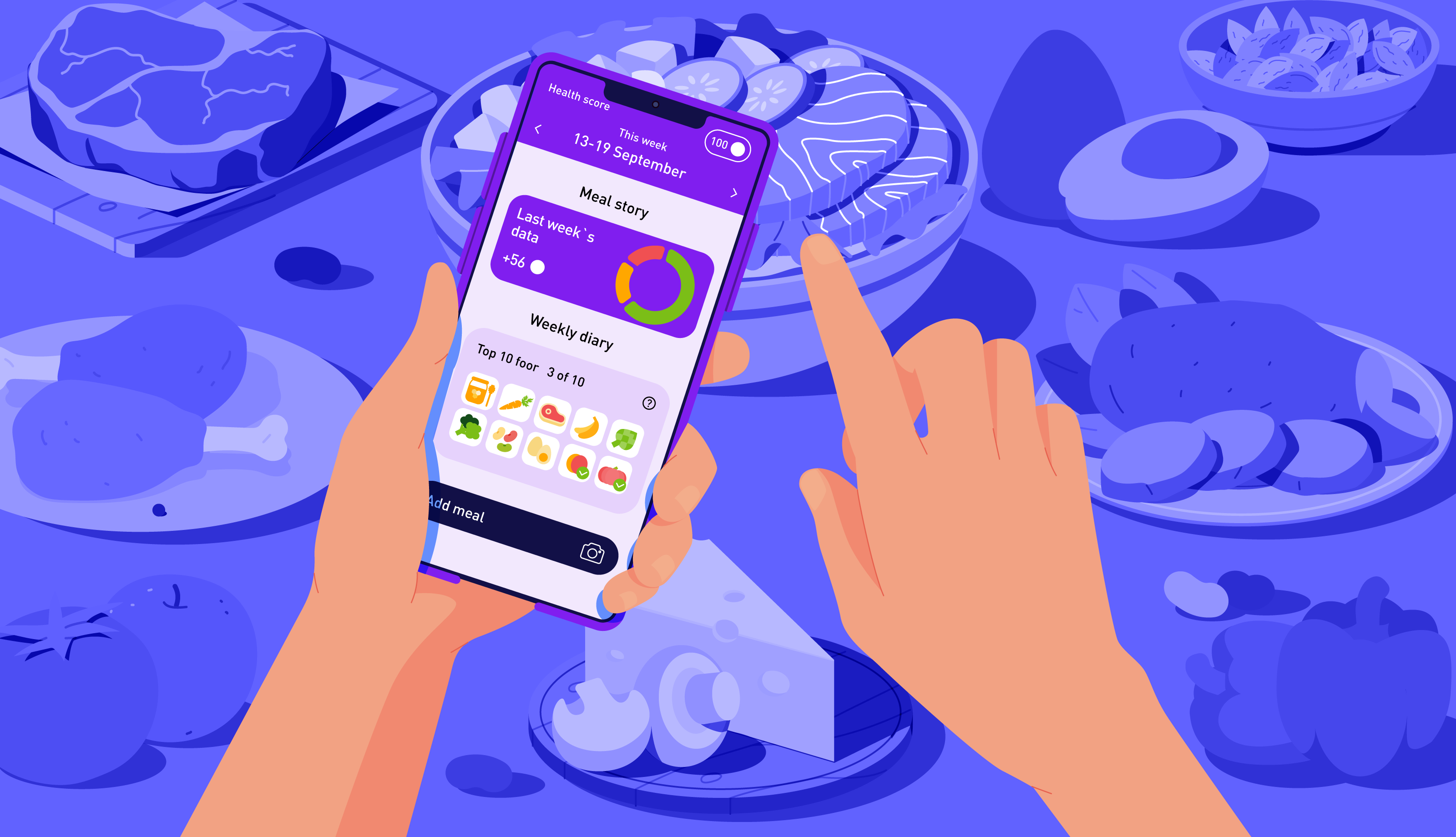We reviewed the most popular food diary apps and templates in 2021 for healthy eating, weight loss, digestive symptoms, and eating disorder recovery.
In theory, keeping a food diary is a great idea, but how many of us have failed after just one day? Or even after the first meal? If you’ve given up, then you’re not alone, and it’s probably not your fault. Many food diaries are poorly designed, and they have a knack for making us feel bad about our choices.
However, there are many excellent reasons to keep a food diary. If you want to lose weight, eat better, or figure out what’s triggering your IBS, then a food log is probably one of the first things a nutritionist or dietitian will ask you to do. It’s also a great starting point if you want to take control of your health on your own.

The best food diary app is designed for a specific intention like weight loss or symptom tracking. It should use AI food recognition software that allows you to take pictures of your meals because this is the most precise method for tracking your food intake and recording portion size. Preferably, a food diary app should also allow you to generate reports on your eating habits to identify dietary patterns that influence your food choices.
This article reviews the top food diary options online with pros and cons to help you find the best one. Whether you’re looking for a printable food diary, a food diary pdf, or a food diary app, we’ve got you covered. Plus, most of them are free.
How to keep a food diary
1. Figure out your goal: what will the food diary help you achieve?
2. Set an end date: your food diary has a goal, it’s not a lifestyle.
3. Don’t wait, record your food intake immediately or you’ll forget.
4. Be consistent and record everything you eat and drink.
5. Be honest about your food intake and don’t feel bad about it.
6. Show it to a dietitian or nutritionist to get expert dietary advice.
Keeping a food diary can be very simple. Choose the most basic printable food diary options for short-term purposes. Alternatively, download an app that takes into account many metrics and data from other sources (like fitness apps) if you’re trying to find answers to complex health problems like digestive symptoms.
Table of contents
- How to keep a food diary
- CDC printable food diary
- Harvard Health printable diary
- Atlas gut microbiome diary
- Eat the rainbow food diary
- IBS food diary by MySymptoms
- Gut Stuff food diary book
- Noom food diary for weight loss
- Slimming World food diary
- Weight Watchers food diary
- ED and anorexia food diary Rise Up
General food diary
A daily food diary is a short-term tool to help you record your food intake and give your healthcare practitioner insight into what you eat, how you eat, and when you eat it. This information contains valuable clues that can help create a tailored eating plan for your needs.
CDC Food Diary (hyper-basic)
America’s Centers For Disease Control is a reputable source of information and guidance for public health, including healthy eating and obesity prevention. They developed a very basic weekly food diary template that you can print off and fill in.
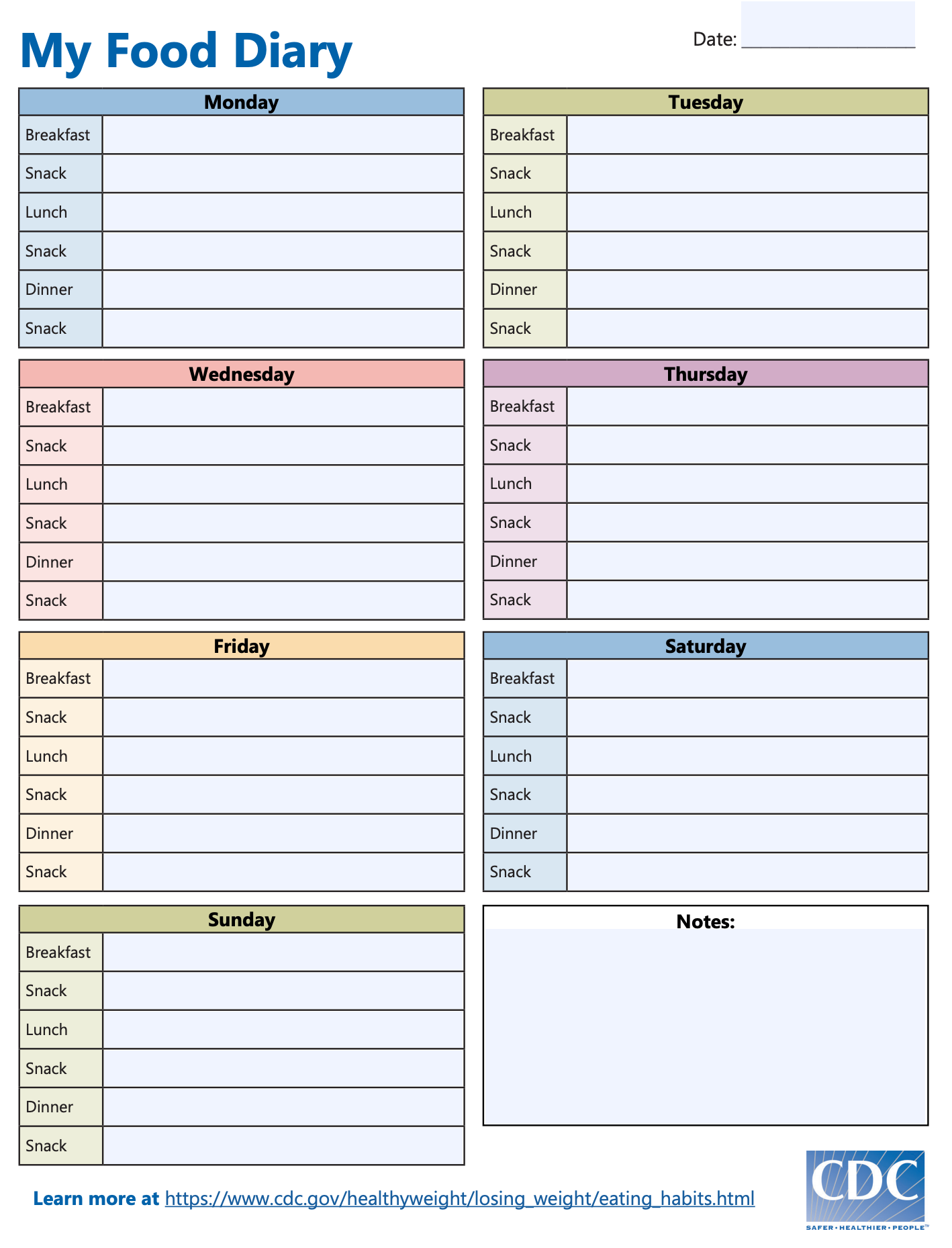
Pros: This A4 printable food diary sheet structures your daily eating habits. It includes a line for three meals and three snacks. It’s free, uncomplicated, and you only need to print one per week.
Cons: There is only one line for each meal and snack, and that can limit how much you can fit on the food diary sheets. There’s no place to put portions or serving size, time of day, or extra lines for unplanned snacks.
Harvard Health food diary (comprehensive)
Harvard Health is an excellent source of plain and simple health and nutrition advice backed by science. Their food diary printable template allows you to track the time and place of when you ate, hunger, mood, and servings of fruit and vegetables.
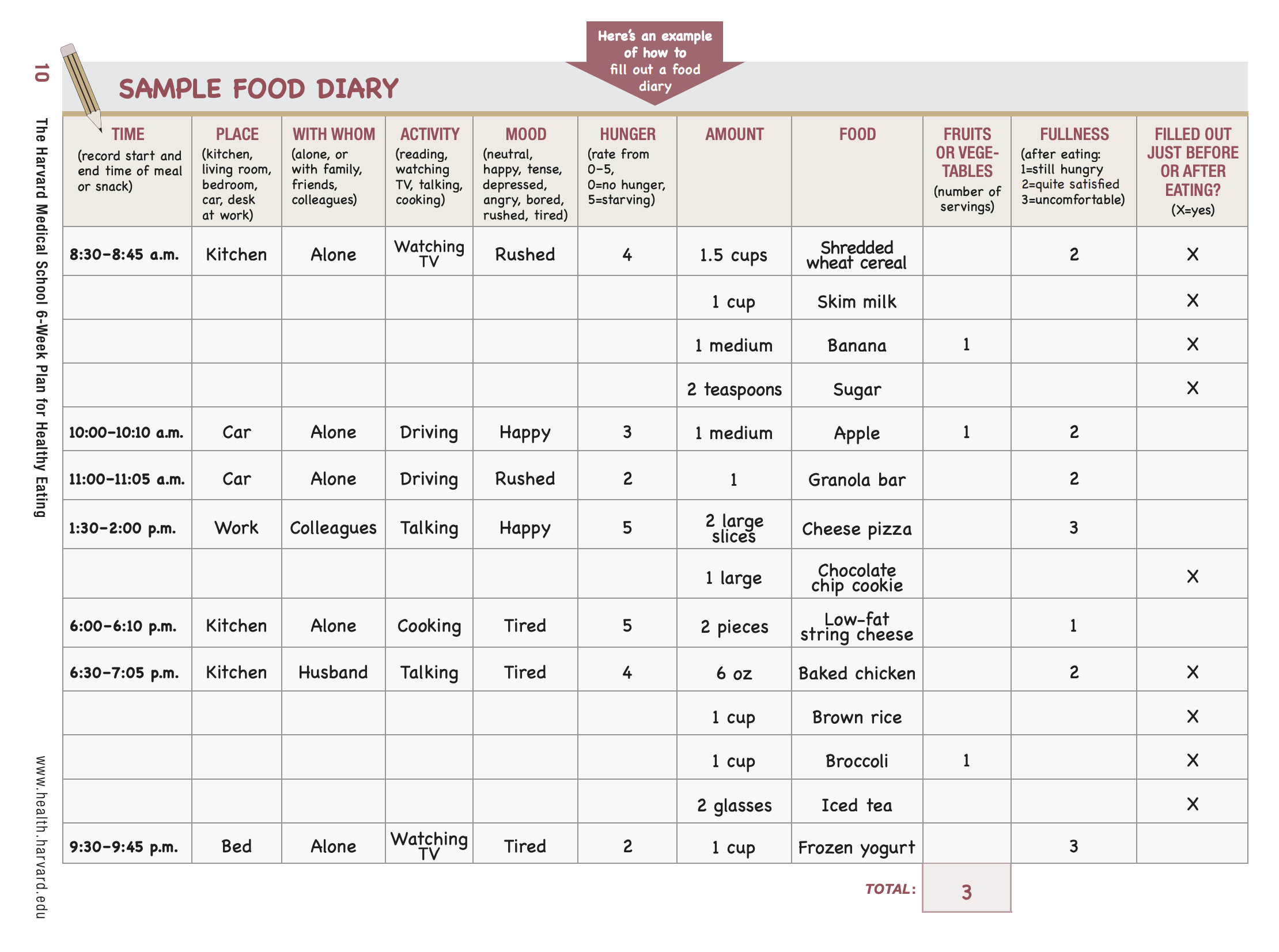
Pros: This comprehensive log starts with a sample food diary to show you how to fill it in. It allows you to track hunger and mood to identify behaviours and bad habits that you can address to improve your diet, like mindless eating in front of the TV and stress eating.
Cons: If you don’t fill it out immediately after eating, then you might miss out on important information. It’s very comprehensive, which can be tiresome to fill out and it has a coloured background, which can drain printing cartridges.
☝️TIP☝️ Don’t forget to check out food diary Amazon options because there are many different formats, purposes, and bindings to choose from.
Food diary for gut health
If you’re having digestive problems, then you are not alone. In fact, about 40% of people worldwide meet the criteria for a functional gastrointestinal disorder (symptoms with no obvious cause). Sadly, digestive problems are hard to diagnose and treat – this is where a food diary can help.

Atlas microbiome food diary
If you’ve taken the Atlas Microbiome Test, then you get free access to a photo food diary that allows you to snap a pic of your meals. This healthy food diary rates your meal based on if it’s good or bad for the good bacteria in your gut. It’s available for Android and iOS.
A 2020 study confirms that food photo diaries are the best option for food tracking because they are much more precise. It takes the burden off of you to log every ingredient or weigh your meals, and it provides an archive of relevant dietary information for your nutritionist.
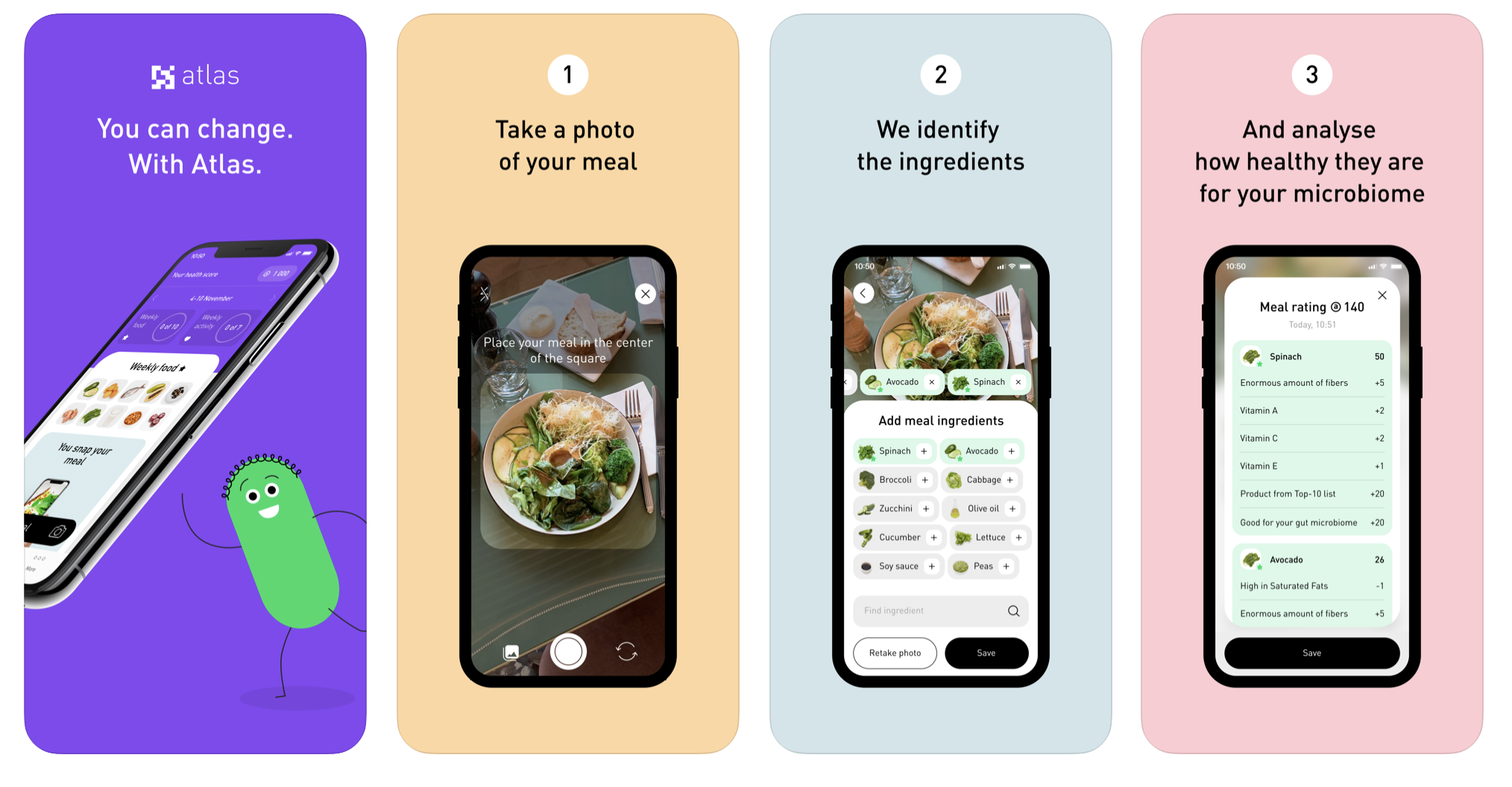
Pros: It’s quick, easy, and free if you’ve taken our test. It uses reliable scientific evidence to rate how microbiome-friendly your food choices are. It includes a free rainbow food tracker that helps you diversify your diet for gut and whole-body health. Plus, your nutritionist can access your food and see your pics to help you with your gut health goals.
Cons: You can only use it if you’ve taken the Atlas Microbiome Test. It’s very much focused on optimising your gut microbiome to enhance your wellbeing, so it doesn’t give you information about calories or allow you to integrate fitness data.
IBS food diary: MySymptoms
MySymptoms is the best food diary app for tracking digestive symptoms caused by irritable bowel syndrome, food sensitivities, and intolerances, as well as inflammatory bowel disease. It is a data-driven app that maps your food intake and your symptoms to identify trigger foods and situations. It includes sleep and stress ratings, bowel movements, and symptom intensity.
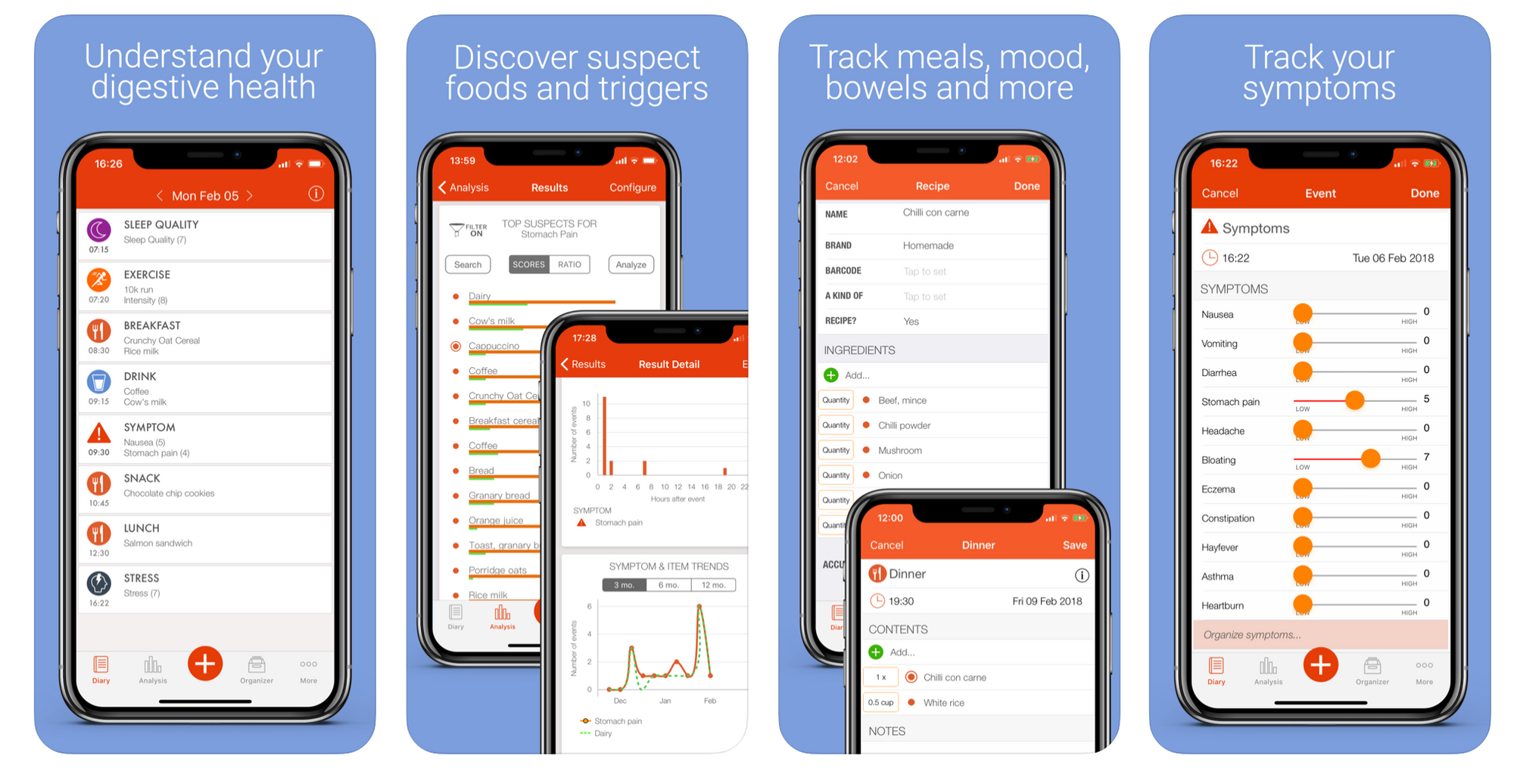
Pros: This app records data and generates charts to help find what’s triggering your episodes of digestive comfort. It’s a real food and symptom diary that tracks lots of different metrics, not just food, to give a broad picture of how your life is interacting with your gut health. You can also generate food diary pdf reports.
Cons: MySymptoms finds associations between different factors, but it doesn’t provide causal relationships. For example, this food symptom diary might find a relationship between a bad night’s sleep and your symptoms, but what if something else actually disturbed your sleep and caused the symptom? This is worth bearing in mind.
Healthy food diary app: Eat the rainbow
Eat The Rainbow is a great healthy food diary that doesn’t focus on calories. Instead, it’s designed to encourage people to diversify their diet using colourful plant foods. It comes with a comprehensive list of healthy foods to eat and it allows you to set weekly goals.

Pros: This simple and uncomplicated app wants to help you eat better. It also wants to educate you with references to the scientific facts that support eating the rainbow for health. The list of colourful plant foods is great inspiration to get in the kitchen and start cooking.
Cons: It’s a pretty basic app that doesn’t allow you to take photos of your food. It can’t be integrated with other sources of data for enhanced results on how you’re helping your body.
Food diary book: The Gut stuff
The Gut Stuff was started by DJs-turned-gut-aficionados, the Mac Twins. They travel the UK, organising events, discussions, and dinner clubs dedicated to gut health and gut-friendly foods. As part of their ambition to make gut health a hot topic of debate in the UK, they’ve released the cutest food diary out there.
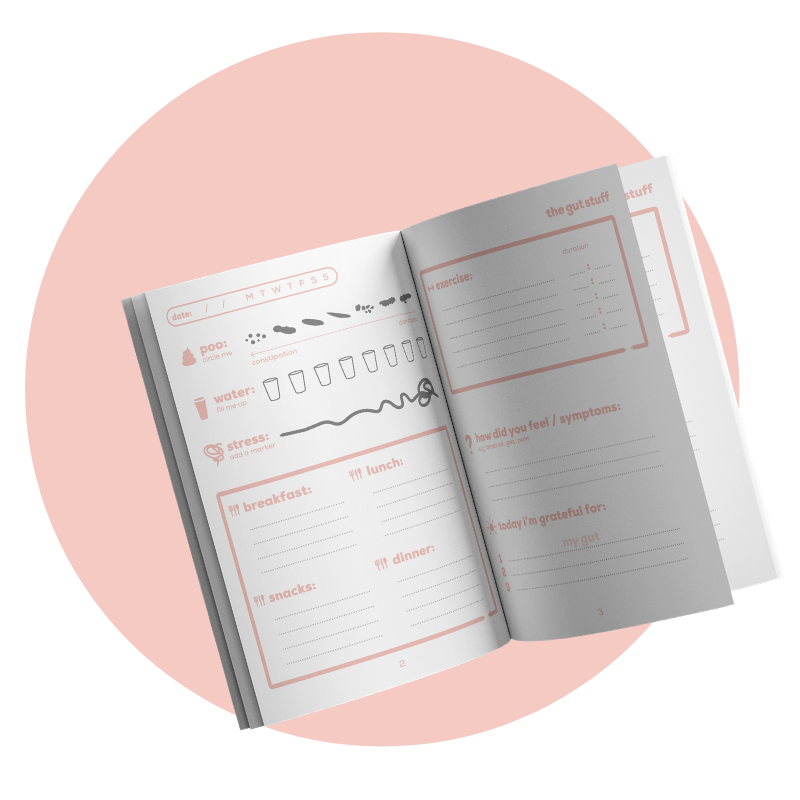
Pros: It allows you to track hydration, mood, symptoms, and food intake. The book includes awesome gut health tips to help you make better choices for your digestive health every day. And let’s face it, it just looks like a great birthday or Christmas gift.
Cons: It’s a beautifully printed book that you’ll need to carry around with you if you want to log food, mood, and water intake correctly. While it may suit the purposes of a nutritionist as a food tracker, it’s not a flexible tool that will do calculations for you or integrate data from other sources.
Food diary for weight loss
A food diary can support weight loss as part of a structured plan overseen by your doctor or dietitian for diseases like type II diabetes and obesity. Recording information like your mood, hunger levels, and eating context (stress eating, mindless eating, binge eating) is especially important because they provide valuable information about the role of food in your life.
However, there are limitations and risks. For example, studies show that people tend to underreport what they’ve eaten and overestimate the portions of healthy food. Plus, food diaries can be triggering for people with a history of eating disorders.
It’s essential to evaluate why you want to lose weight because there are plenty of bad reasons to go on a diet. Hollywood, Instagram, and smartphone filters have created unattainable physical goals by promoting celebrities that are underweight (or look like they are). If this is your aim, consider talking to a nutritionist about your health goals to set realistic aims that won’t take a toll on your health.
Weight loss food tracker: Noom
Noom is an all-encompassing food and exercise diary app that allows you to log what you’ve eaten, your weight, and physical activity. It offers support from wellness coaches (which are not as qualified dietitians!) and has good reviews.
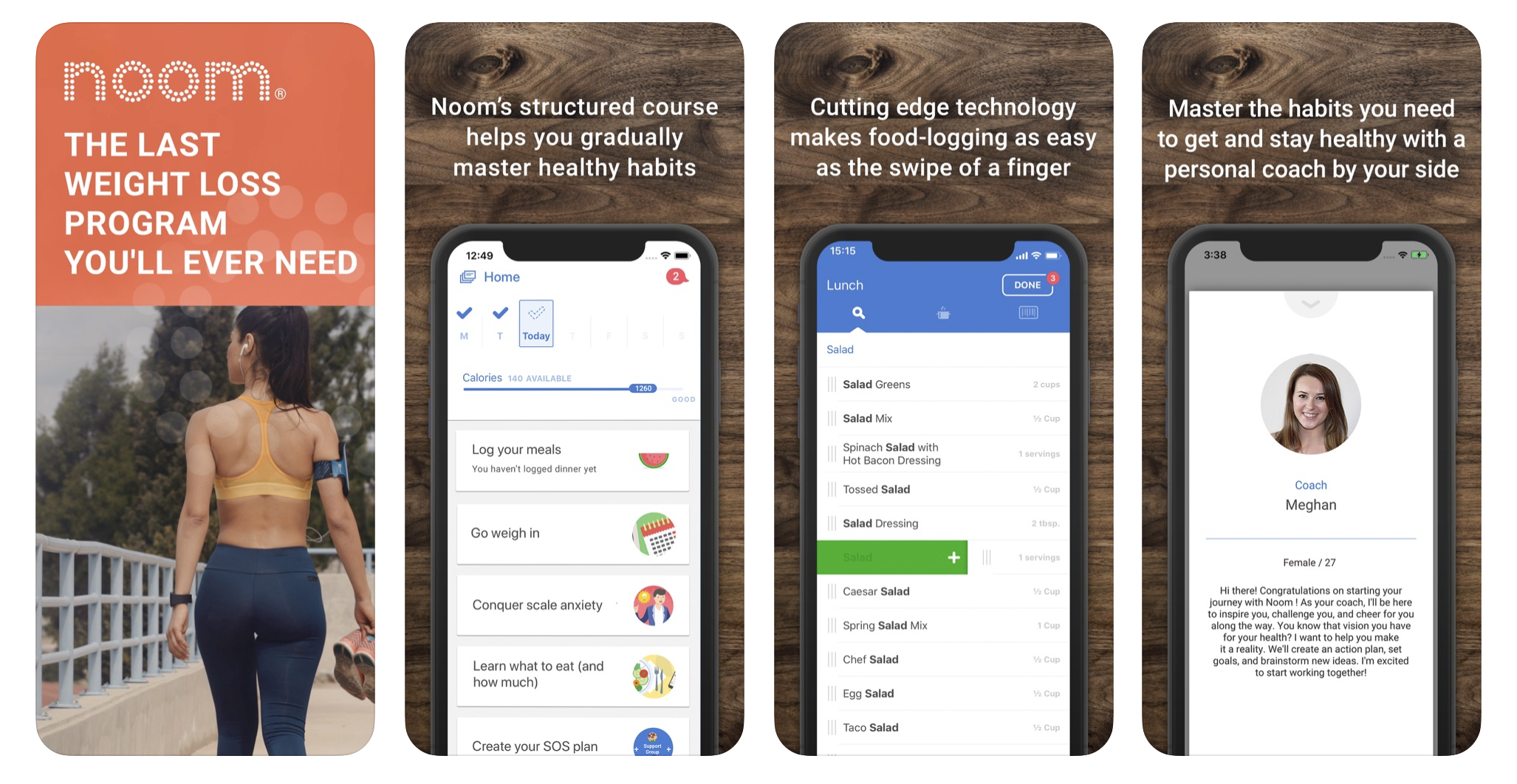
In fact, one 2016 study in Nature, a reputable science journal, found that it was an effective weight loss app for the majority of its users. For an expert opinion, check out this detailed Noom review by registered dietitian, Nora Minno.
Pros: Noom doesn’t force you to adopt a strict diet, and it doesn’t promote fad diets like keto or gluten-free. Foods are simply colour-coded: green for good, and red for not-so-healthy foods. It can connect to your smartphone’s health app to integrate data from your workouts.
Cons: It’s expensive – the full Noom program costs £41.99 per month. Plus, Noom isn’t designed for people with diagnosed health conditions, so if you have diabetes or thyroid problems, you should consult your doctor or a dietitian first.
Slimming World food diary
Slimming World (r) is a company with branches all over the UK and a digital program too. It focuses on helping people make healthier choices without completely overhauling their diet. Their food diary allows members to track “free foods”, “super-free foods”, and “syns”.
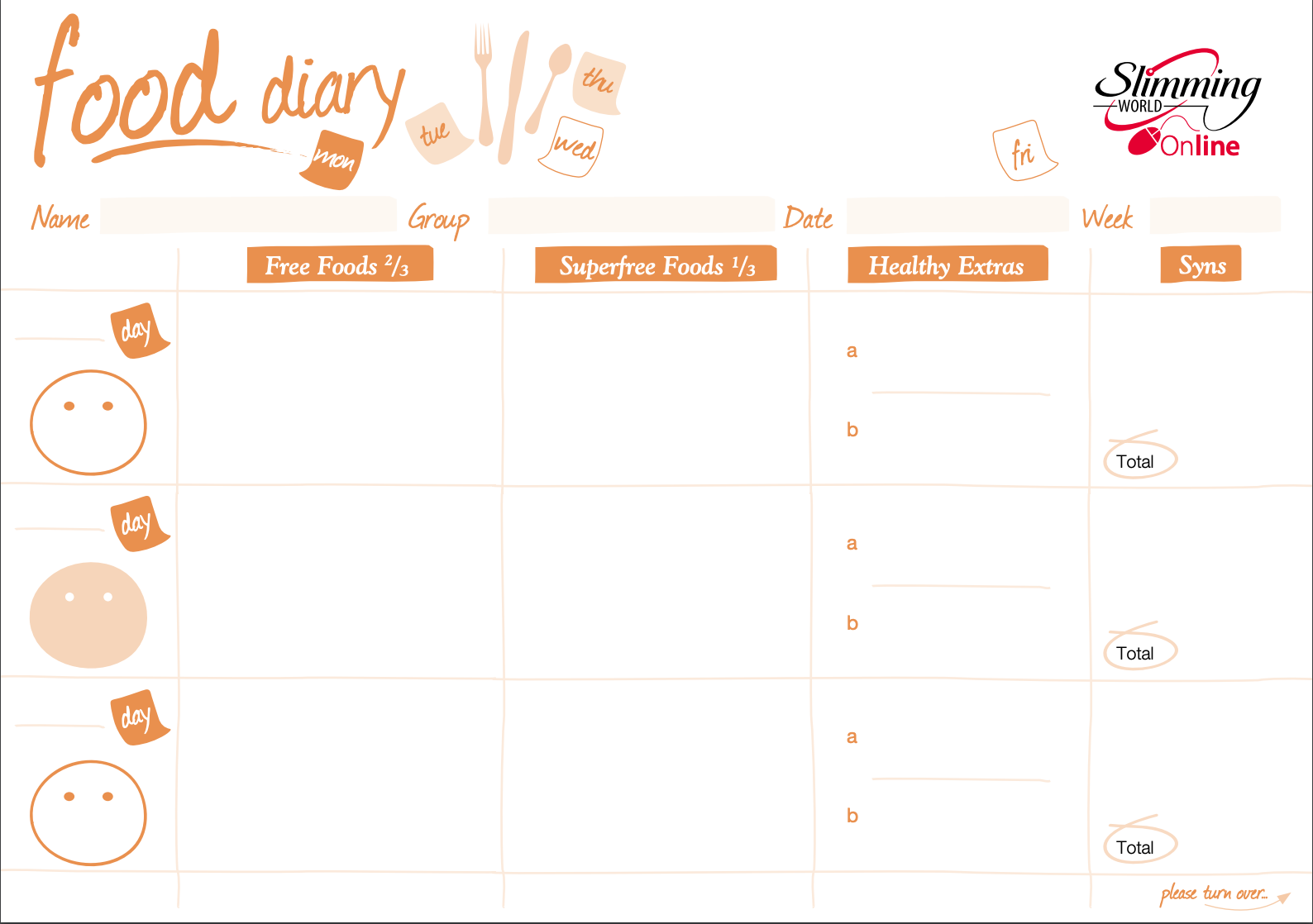
Pros: One study of nearly 1.4 million Slimming World members showed that this program could really support weight loss over 3 months. This Slimming World food diary printable is great for older members who aren’t smart-phone savvy.
Cons: This printable food diary looks like it was designed for children, and you have to join Slimming World (r) for it to make any sense (it costs £5-10 per week). The science behind their “free” and “super-free” food lists is hard to verify and some high-glycemic food recommendations (i.e., pasta) may not be suitable for people with blood sugar problems like insulin resistance, diabetes, and prediabetes.
Weight watchers food diary
Weight Watchers (r) is another weight loss company with groups around the country where everything you eat is rated on a points system. The Weight Watchers ® program is designed like a bank account, in which you are allotted food points to spend every week. You can track your goals in the Weight Watchers food diary app.
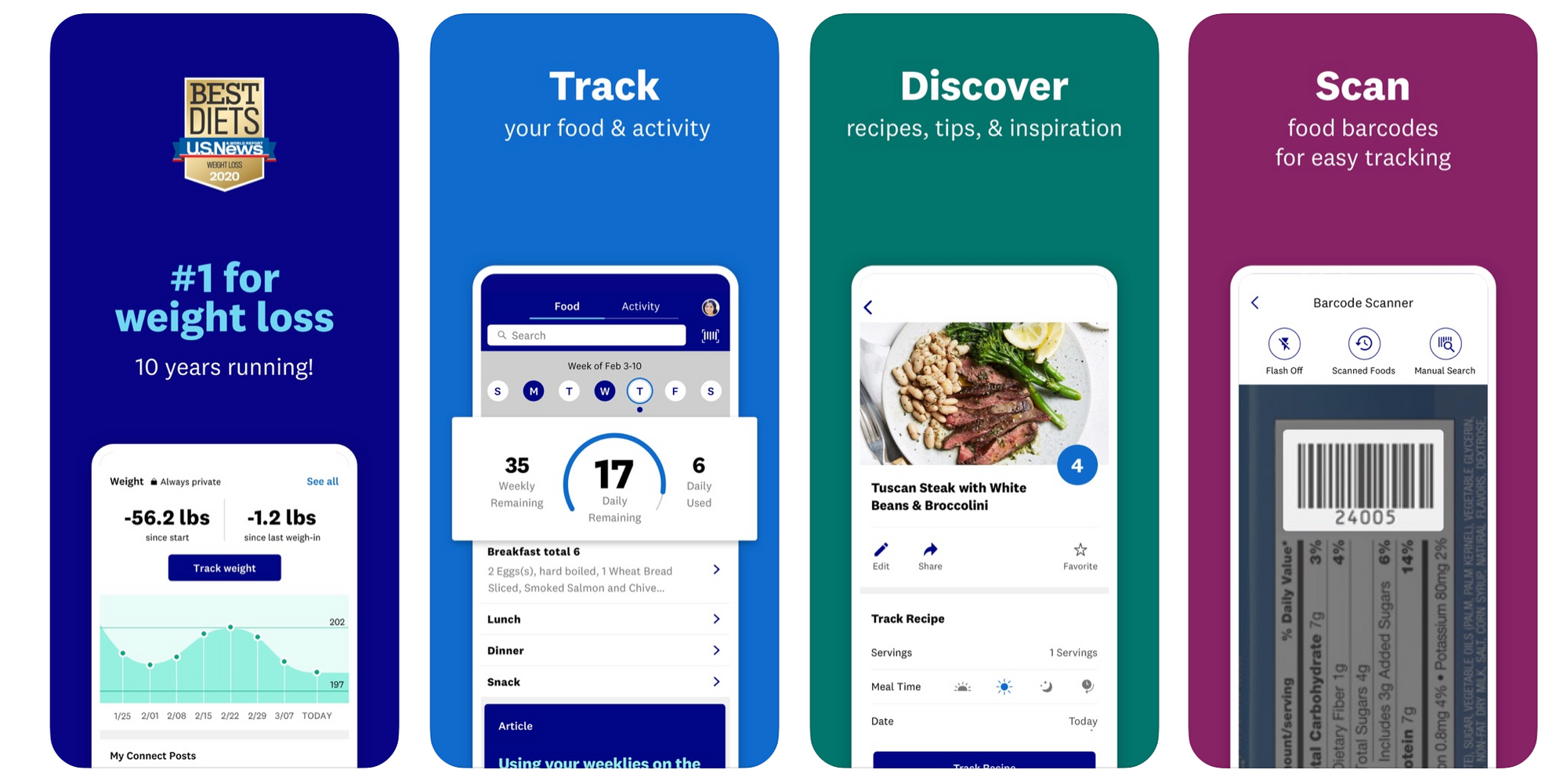
Pros: There is a barcode scanner to help you make the right choices where it counts: at the supermarket. You can earn food points by doing exercise and the app gives access to 24/7 coaching.
Cons: You have to pay monthly dues (£12.99). This program also seeks to gamify and monetise every part of their program, and while they do give recipes and eating advice, they also make money off branded food options and a range of ready meals.
Eating disorders and anorexia food diary: Rise up + recover app
This food diary free app by the Recovery Warriors turns the food diary into an ally when recovering from an eating disorder. While a traditional calorie-counting food diary can make eating disorders worse, this app focuses on mental wellbeing, state of mind, and motivation with a non-threatening food log without the pressure to add portion size or calories.
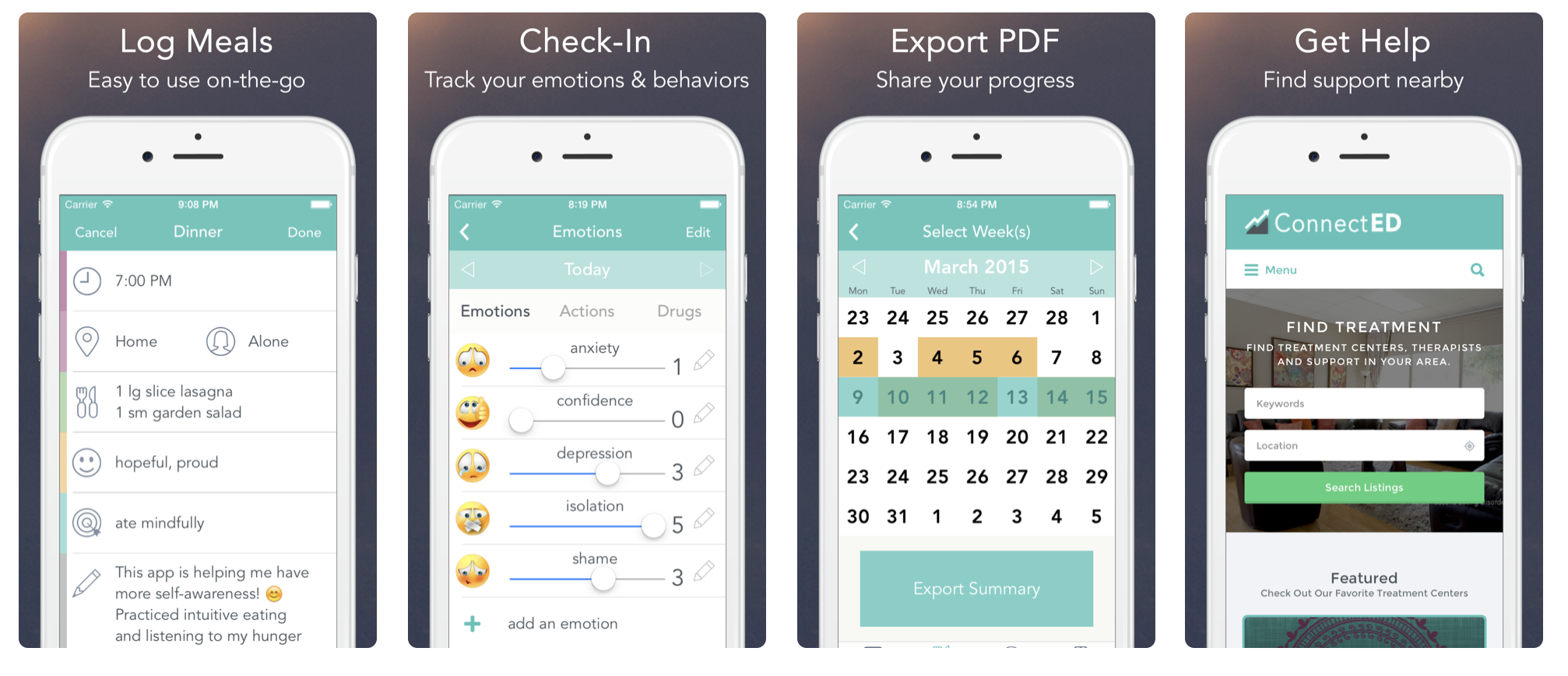
Pros: It is designed to support self-monitoring within the framework of cognitive behavioural therapy to overcome eating disorders. It also provides access to support and medical help in the nearby area.
Cons: Some people find the motivational quotes offensive, disheartening, or simply annoying, and it may deter them from using the app to help monitor and manage their eating disorder.


